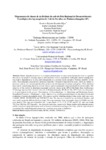Use este identificador para citar ou linkar para este item:
http://www.alice.cnptia.embrapa.br/alice/handle/doc/945616| Título: | Mapeamento de classes de declividade da sede do Polo Regional de Desenvolvimento Tecnológico dos Agronegócios do Vale do Paraíba, em Pindamonhangaba (SP). |
| Autoria: | SILVA, G. B. S. da  PEREIRA, K. C.   FARIA, D. P.   SOUZA, L. C. N. DE   NOGUEIRA, S. F.   |
| Afiliação: | GUSTAVO BAYMA SIQUEIRA DA SILVA, CNPM; KARLA CONCEIÇÃO PEREIRA, SAA-APTA; DANIELA PAULA FARIA, UFPR; LAYS CAROLLINE NEGRI DE SOUZA, BOLSISTA CNPM; SANDRA FURLAN NOGUEIRA, CNPM. |
| Ano de publicação: | 2012 |
| Referência: | In: SYMPOSIUM SOCIEDADE DE ESPECIALISTAS LATINO-AMERICANOS EM SENSORIAMENTO REMOTO, 2012, Cayenne. Anais... Cayenne, Guiana Francesa, 2012. |
| Páginas: | 8 p. |
| Conteúdo: | Pasture degradation process is a complex phenomenon: its causes and consequences lead to a gradual decrease in the pasture's carrying capacity and culminate with its degradation. Inadequate pasture management may lead to degradation at its area, and consequently to a decrease in the amount of biomass available for the cattle. These degraded areas deserve attention, especially if located in high declivity areas, which are subject to processes such as soil erosion and therefore prone to the development of ravines and gullies. These declivity areas can be located using data from several sources, such as topographic maps and digital elevation models. The objective of this work is to determine topography declivity classes at the APTA (São Paulo State Agribusiness Technology Agency) farm, located in the city of Pindamonhangaba, SP, Brazil. The APTA farm was chosen due to its participation in the project "Development of Geotechnologies for Identifying and Monitoring Pasture Degradation Processes ? Geodegrade", whose objective is to develop geotechnologies for the identification and monitoring of pasture degradation levels. The sources used for obtaining altimetry data on the study area were 1:10,000, SRTM, ASTER DTM and TOPODATA data. The data were compiled in a georeferred database, and were used to generate different declivity maps. The maps generated from topographic maps (1:10,000) were the most detailed. The map was reclassified into 5 slope classes: 0°-3°; 3°-8°; 8°-20° and 20°-45° and were found 731.2 ha; 546.9 ha; 132.2 ha and 1.1 ha of area for each class, respectively. Future studies in Geodegrade project will be carried out using information such as biomass estimation according to declivity, with the expectation of evaluating if the studied degraded pastures are located in areas prone to landslides. |
| NAL Thesaurus: | Digital elevation models |
| Palavras-chave: | ASTER SRTM TOPODATA |
| Tipo do material: | Artigo em anais e proceedings |
| Acesso: | openAccess |
| Aparece nas coleções: | Artigo em anais de congresso (CNPM)  |
Arquivos associados a este item:
| Arquivo | Descrição | Tamanho | Formato | |
|---|---|---|---|---|
| Bayma.pdf | 775,16 kB | Adobe PDF |  Visualizar/Abrir |









